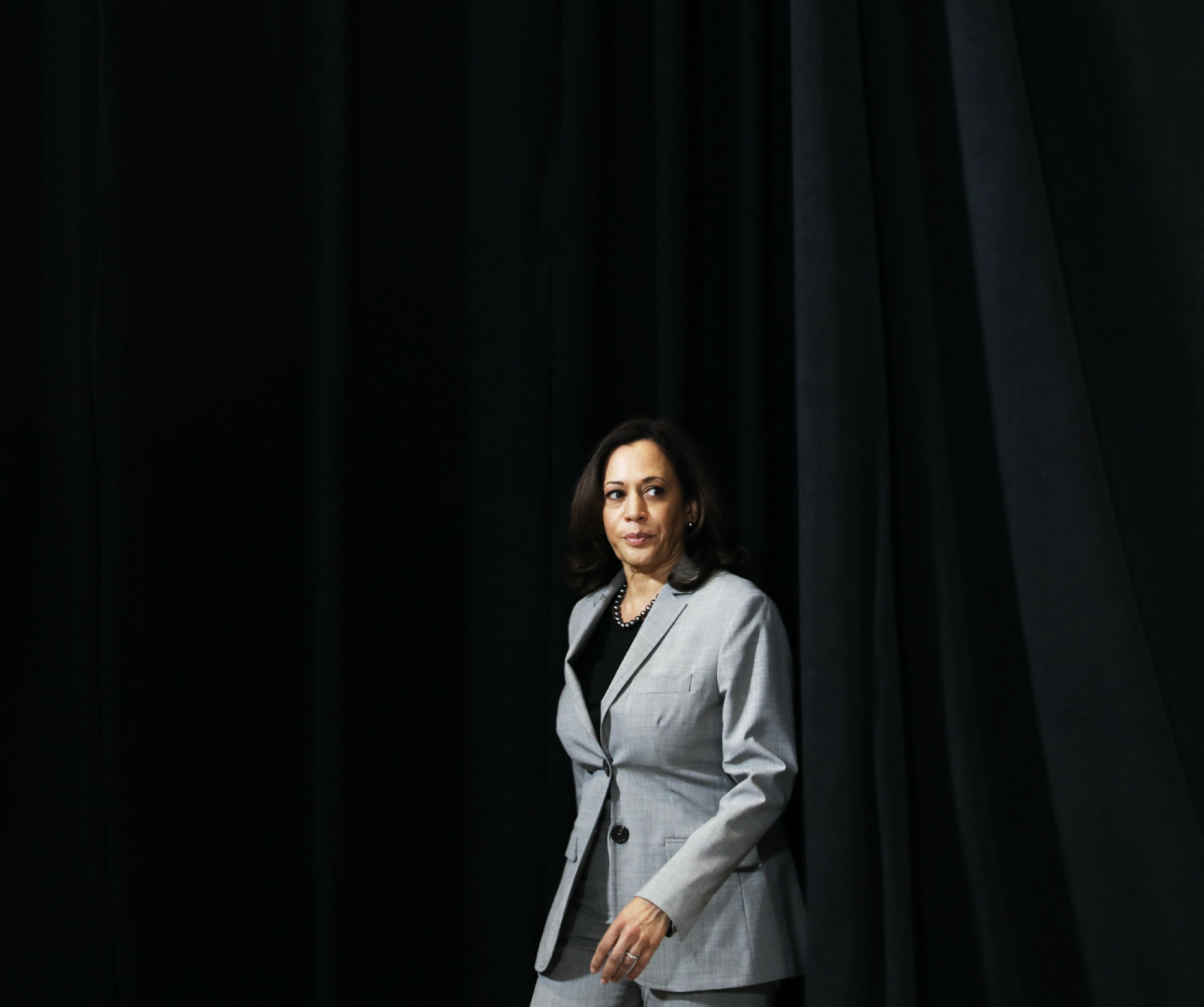“It’s time for women to be judged on their merits — and for the media to take a critical look at their biased coverage.”
Media coverage of Sen. Kamala Harris’ vice presidential nomination disproportionately focused on her race and gender, according to a report published by Time’s Up Now, an organization founded in the wake of the #MeToo movement that aims to fight gender-based discrimination. A quarter of the analyzed coverage incorporated at least one racist or sexist stereotype — most of which derived from the repetition of President Donald Trump’s ad hominem attacks on Harris.
The report, released last week, compared media coverage of the announcement of Harris’ nomination this year and 2016 coverage of the announcements of the vice presidential nominations of then-Gov. Mike Pence of Indiana and Sen. Tim Kaine, D-Va.
The racist and sexist “angry Black woman” trope was the most prevalent stereotype in “mainstream U.S. top-tier media coverage” of Harris, emerging in 13 percent of the analyzed coverage surrounding the August announcement that she would be Joe Biden’s running mate. Trump’s attacks on Harris’ character — as “nasty,” “mad,” and “mean” — largely fueled the prevalence of that trope, according to the report.
Some journalists also contributed to it — albeit less than Trump did overall — by characterizing Harris as “uncooperative” and “unlikeable,” the report noted. But most biased coverage resulted from mainstream news outlets perpetuating racist and sexist storylines: References to the “birtherism” conspiracy theory, for example, appeared in 10 percent of all coverage.
By contrast, the 2016 veepstakes coverage overwhelmingly described Pence and Kaine as “experienced” and “safe” choices — while Harris drew more negative adjectives, including sexist and racist language.
At a time when the journalism industry faces its own reckoning over race and racism within the industry, the report shows the persistence of sexist and racist biases in both media and politics, and the unique blend of both that Black women experience — a combination dubbed “misogynoir” by Moya Bailey, an assistant professor of Africana studies and women’s, gender and sexuality studies at Northeastern University. The report was published as part of Time’s Up Now’s recently announced nonpartisan We Have Her Back initiative, which aims to raise awareness of how sexism and racism affect coverage of female candidates.
“When women, and especially women of color, run for office, they are subjected to a double standard that has nothing to do with their qualifications and everything to do with this country’s history of racism and sexism,” Tina Tchen, the organization’s president and CEO, said in a statement about the report. “It’s time for women to be judged on their merits — and for the media to take a critical look at their biased coverage.”
The organization commissioned the research and analytics firm Edelman Data and Intelligence to compare how Harris, Pence and Kaine were portrayed in news media coverage during the week before, and the two weeks after, their announcements as running mates. The 661 articles, split between coverage in 2016 and in 2020, were sourced from news outlets including NBC News, ABC News, CNBC, The Wall Street Journal, The Washington Post, The New York Times and others.
In the report, NBC was listed as one of the outlets that covered Harris’s potential to help boost Black voter turnout in the South, published an op-ed on the biased rhetoric she would likely face on the campaign trail, and reported Trump’s reaction to Harris’s nomination by using language aligned with the “angry Black woman” stereotype.
The “angry Black woman” trope that plagued Harris’ characterization in a quarter of the analyzed coverage has deep historical roots, according to Treva Lindsey, an associate professor of women’s, gender and sexuality studies at Ohio State University. Especially during Reconstruction, the trope served to continue the dehumanization of Black women following slavery and to reify white womanhood, Lindsey said. And 20th century pop culture portrayals of Black women strengthened its popularity, Lindsey added: In particular, the character of Sapphire in the radio and television sitcom “Amos ‘n’ Andy,” who was portrayed as nagging and aggressive, gave rise to a stereotype of the same name — which became a synonym for “angry Black woman.”
The racist framing relies on a stereotypical — and sexist — notion of women’s outsize emotionality, coupled with anti-Black racism, according to Soraya Chemaly, author of “Rage Becomes Her: The Power of Women’s Anger” and executive director of the Representation Project, an organization that aims to shift public attitudes about gender.
“What we see with the ‘angry Black woman’ trope is this inherent idea of irrationality, of extreme emotional response, and of unnecessary aggression,” Chemaly said.
Of the trope’s intended impact on Harris’ candidacy, Lindsey said it “becomes an easy way to dismiss her, discredit her, devalue her contributions to the political landscape.”
In her first joint interview with Biden since their announcement as running mates, Harris shied away from explicitly blaming Trump’s attacks on racism and sexism, and instead characterized his descriptions of her as distractions from his administration.
“I think that there is so much about what comes out of Donald Trump’s mouth that is designed to distract the American people from what he is doing every day that is about neglect, negligence and harm to the American people,” Harris told CNN in August.
But when asked during the primary if she thought Trump was racist, Harris told the Root, “I don’t think you can reach any other conclusion.”
Trump’s senior adviser, Katrina Pierson, has denied that Trump’s attacks on Harris were motivated by racism or sexism, telling reporters in August that Trump and his daughter Ivanka donated a combined $8,000 as private citizens to then-prosecutor Harris when she ran for California attorney general.
The report also found that while 61 percent of the analyzed coverage of Harris referred to her race and gender, only 5 percent of the 2016 coverage of Pence and Kaine mentioned their race and gender, underscoring the widespread acceptance of white men as the “default” model for leaders, it notes. Additionally, while Harris’ racial background dominated coverage of the announcement of her candidacy, being mentioned in 36 percent of analyzed stories, Pence’s and Kaine’s professional backgrounds and accomplishments dominated the analyzed coverage announcing their candidacies.
The dominance of the focus on Harris’ ancestry in coverage is unsurprising, Lindsey said, given the historic nature of her candidacy as the first woman of color to be nominated for national office by a major political party.
“We must acknowledge what it means that a Black and South Asian woman is the vice presidential nominee for the Democratic Party — that’s a huge thing,” she said. “When we talk about these people running for offices, it’s equally important to interrogate how whiteness has become the default and why, and how maleness has become the default and why.”
The Time’s Up Now report notes that journalists can create more equitable coverage of political candidates by avoiding invoking identity in routine coverage, actively debunking political attacks rooted in racism and sexism, using gender-neutral language, and engaging third-party experts on gender, race and representation when possible.
But the problem of inequitable news coverage is a systemic issue within the journalism industry, Chemaly said. She pointed to the fact that white men make up the majority of newsroom employees and produce the majority of political journalism in America, and therefore set the standards and norms for coverage.
“We know that the experience of being a white man in that environment becomes conflated with humanity, objectivity and normalcy,” Chemaly said.
Journalists also must use more precise language to contextualize individual ad hominem attacks as racist, sexist and whatever other category of systemic discrimination they fall into, Chemaly added.
To Lindsey, that requires distinguishing between the use of “race” and “racism.”
“When we talk about reporting on issues of racism, we need to name it as such,” she said. “Race is an identification; racism is a dynamic of power that’s rooted in an identification of a person.”
Chemaly added that journalists should be more critical of the ways their own race, gender and other identities may affect their worldview and potentially the journalistic process.
“In order for journalists to ethically and soundly change the way they’re reporting, they first need to be introspective — they need to understand their own identities and understand how their own identities are implicated in their framing and sourcing of a story,” Chemaly said. “It affects everything: what questions we ask, what photographs we use, the wording of our headlines.”




